Roses are adorable plants that have won the hearts of many people with their beauty and aroma. However, one should not assume that there are no colors that can compete with them.
The question of which flowers are the most beautiful is extremely subjective and depends on the preferences and priorities of a particular person. All people are different, and their tastes are also different, but one thing can be said for certain, that the community of flower growers and simply lovers of admiring flowers does not live by roses alone. There are about 270 thousand species of flowering plants on the planet., and everyone can find their admirers. Among the flowering ones, there are those that have absolutely nothing in common with roses, but there are so similar that they can be mistaken for one of the varieties of roses. Let's get to know similar representatives closer.
Eustoma
Another name for eustoma is Lisianthus Russell. This plant can grow from 12 to 150 cm in height, depending on its belonging to a particular variety. The number of eustoma flowers can vary up to 20 pieces. Flowering occurs magnificently due to the gradual blooming of flowers and the large diameter of the buds - from 5 to 15 cm... Petals come in two varieties: double and non-double. The Lisianthus should be protected from direct sunlight as this can harm it. The optimum temperature for growth is 22 degrees. Vegetative propagation is impossible due to the fragility of the roots and the lack of shoots.
Ranunculus
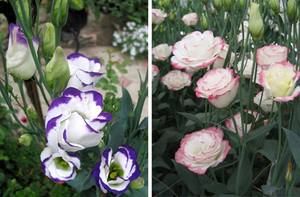
Another name for Ranunculus is garden buttercup. It is a dwarf, up to 50 cm, perennial garden plant with about 600 varieties.... The most popular among flower growers are the Persian and African varieties of Ranunculus. With regard to different varieties, the shape of the bud of the garden buttercup repeats the shape of the outlines of roses, peonies and poppies. Prefers light or partial shade. Feels comfortable in loose, moderately moist soil. Reproduction is carried out through seeds or by transplanting root tubers.
Hellebore
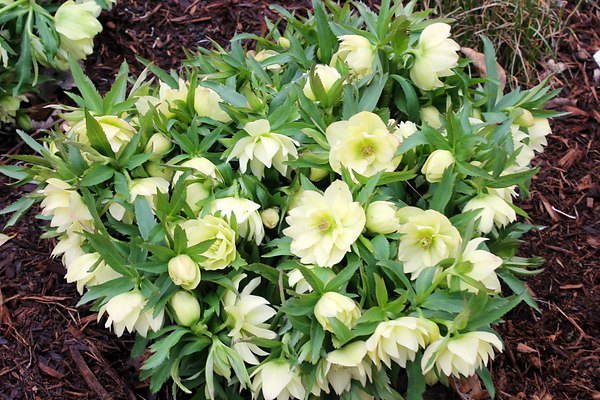
The hellebore or otherwise Gelleborus is a perennial plant that, in addition to its attractive appearance, also has medicinal properties. There are about 15 species of hellebore, but the most popular of them are Hybrid hellebore and Caucasian hellebore. The height of the plant relative to the variety is in the range from 40 to 70 cm. Abundant flowering: several flowers can be located on one stem. Flowers are varied in shape, up to 8 cm in diameter. The shade is usually white-green or yellowish. Loves partial shade, feels comfortable among shrubs and trees.
The best option is seed reproduction, since adult plants do not tolerate transplanting and dividing bushes well. Typically, the seeds ripen in mid-summer. The hellebore does not tolerate frequent transplants, so it is better to propagate it with seeds.
Chinese rose

The Chinese rose, despite the name, does not belong to the same genus with roses. It belongs to the genus Hibiscus and has an alternative name for Chinese hibiscus. It is so called because of the similarity of the growth area. Has successfully spread all over the world. It is a shrub up to 3 m high... The flowers are originally red shades with a diameter of up to 16 cm. As a result of selection, varieties of other shades and bud sizes were obtained. Loves a hot, humid climate, prefers a sufficient amount of sunlight. In general, it is unpretentious.
Begonia

The birthplace of begonias is the tropics and subtropics, so the plant is warm, light and moisture-loving. There are about 1000 species with distinctive features of the shapes and shades of flowers and leaves. In view of such a variety of begonias, they are divided into three groups: shrub, semi-shrub and herbaceous... Florists prefer herbaceous hybrid varieties, since caring for them is the least demanding. The most popular are flowering begonias, which shed their foliage during flowering, and leaf begonias, which retain foliage, but do not bloom as expressively. Reproduction is possible with seeds, cuttings or tubers.
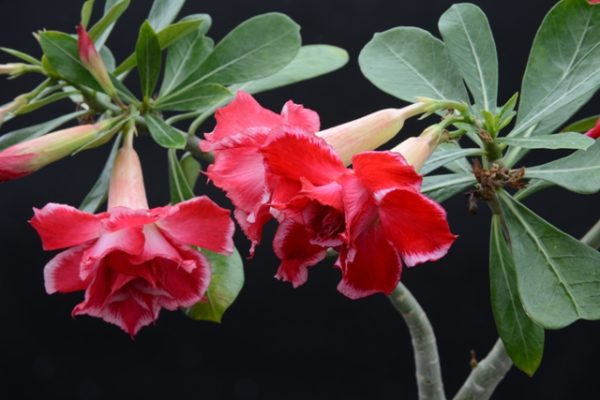
Terry adenium was nicknamed the desert rose because of the shape and bright scarlet color of the flowers. The plant is a short, up to 50 cm, tree with rounded leaves... The homeland of adenium is Africa, so it needs a lot of light and warmth. Does not like shade, feels comfortable under the sun's rays. The average comfortable temperature for him is +25 degrees. The bud consists of three or two rows of petals, which is a striking feature of the terry aleniums. Flower size up to 8 cm in diameter. Adenium juice is poisonous, so you need to be as careful with it as possible.
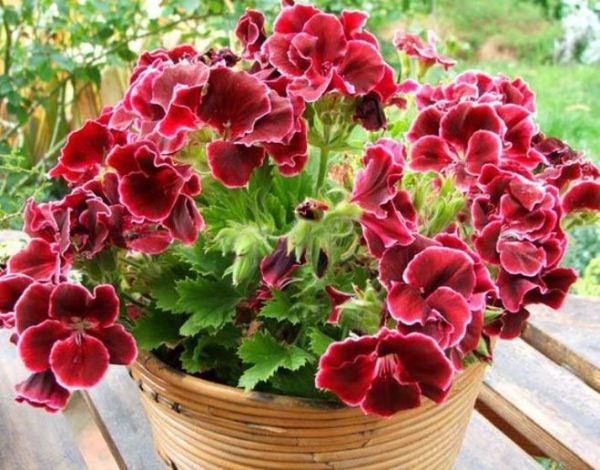
Geranium - the famous perennial indoor plant... It grows up to 50 cm. The leaves are rich green, the flowers are large, consisting of petals of the same shape and capable of gathering in inflorescences. There are 400 known geranium species, many varieties have been bred. Unpretentious, easily tolerates a lack of moisture and light, but compensates for this with poor flowering. Drought tolerant and shade-loving species are also found. Propagated by seeds and shoots.
The flower world is amazing, fascinating and diverse, but even in such a variety, you can find similarities and similarities in plants of different types. There is always an opportunity to discover something aesthetically beautiful that echoes what has already been seen: shades, outlines, forms. Even if you are crazy about roses, do not deprive yourself of the pleasure of admiring the beauty of other flowers.... Indeed, among them there are also very similar to your beloved ones.
Among flower growers, this plant has several names ("Eustoma", "Irish rose", "Lisianthus"), and the external resemblance to a rose is striking. The flower belongs to the gentian family, you can grow eustomas in the garden and at home. The flowers have many colors, the leaves are elliptical. Depending on the variety, it can grow up to 70cm. Potted varieties (up to 30cm) are suitable for home conditions.
Breeders from all over the world have worked on the creation of new hybrids and varieties of eustoma, and as a result, it was possible to breed various varietal series with a variety of flower colors.
Among them:
"Kyoto" F1 - non-double series ("White", "Picot Wine Red", "Blue", "Pink"), "Twinkie" F1 - white, pink, yellow, light purple. "Mermaid" F1 (white, pale pink, lilac pink, blue, violet). "Sapphire" F1 ("Blue Chip"), (double white variety).
"Echo" F1 - double series (salmon-pink variety "Champagne", "Pink Pikoti", "Blue", "White", "Yellow", "Pink with a rim", "Lavender", "Blue"). Cinderella F1.
Eustoma will decorate your garden
Eustoma is a very attractive plant with gray, wax-like leaves and large funnel-shaped simple or double flowers of delicate shades. The flowers of the large-flowered eustoma reach 7-8 cm in diameter. They come in a variety of colors - white, pink, lilac, purple, white with a colored border, etc. Half-open flowers look like rosebuds, and when they open completely, they look like large poppies. The stems of the eustoma are strong, 80-90 cm in height, from about the middle they branch strongly, making one plant look like a whole bunch. On one plant, I once counted 35 buds. All varieties of tall eustoma give long stems and are suitable for cutting. And cut flowers stand in a vase for a long time.
Eustoma is gradually conquering our hearts and gardens. Its high decorative qualities, long-term preservation of cut flowers contribute to the fact that eustoma quickly became popular in Europe. For example, in Holland, it ranks among the top ten among cut flowers. And in Poland, at summer flower exhibitions, eustoma is highly valued.
Modern varieties and hybrids
Every year more and more seeds of different varieties and hybrids of eustoma appear on the market. Seeds have now become available not only for professionals, but also for amateur flower growers. When buying eustoma seeds, you need to know that it can be tall and undersized (dwarf). Tall eustoma is grown in gardens, as well as for cut, and undersized is intended for planting in balcony boxes and growing as a room culture.
The second thing you need to pay attention to: on the packet with eustoma seeds is indicated "annual" or "biennial". Of course, choose a one-year-old, since a two-year-old eustoma can only be grown by professional growers who have greenhouses. She will not suit an amateur flower grower, unless it is undersized to grow it in an apartment.
Eustoma flowers can be simple and double. Eustoma with double flowers is, of course, more beautiful than simple ones. As for the color, you can take any: they are all very beautiful.
The seeds of eustoma are small, therefore they are sold mainly in a coated form. So they are clearly visible and convenient to sow.
I really like the ABC F1 terry variety series: Misty Pink, Misty Blue, Purpl, Blue Rome varieties and Echo F1 terry variety series: Champagne, Deep Blue, Rose Picoti varieties and others. The eustoma of these series is distinguished by early flowering, strong shoots 80-90 cm high, on which beautiful large double flowers seem to be planted.
Growing eustoma seedlings at home
Reproduction
Unfortunately, eustoma does not reproduce by dividing the bush - this, as a rule, ends in failure. Since an adult Lisianthus does not tolerate a violation of the root system, all the resulting cuttings may die. Cut off cuttings of eustoma do not take root either. Therefore, the main and most reliable way to propagate this beautifully flowering plant is by seeds.
It is believed that growing eustoma from seeds is not easy, and in culture it requires special skills and knowledge. But it is not so. From personal experience, I was convinced that it is easy to grow eustoma, it is difficult only for the first two months, when it is necessary to create certain conditions for seedlings
Seed sowing dates
Amateur flower growers begin sowing eustoma seeds in winter (December - January). This is due to the fact that the flowering of eustoma occurs in the 15-20th week after the emergence of shoots, therefore, during spring sowing, it simply does not have time to bloom. I sow eustoma seeds from late November to early February. It makes no sense to sow later, I was convinced of this when my first eustomas with buds were covered with snow. We didn’t manage to admire their flowering.
Sowing details
I sow eustoma seeds in disposable cups (50 g) with a light moist peat soil, to which I add sand or perlite to make it looser and more breathable. From purchased substrates, ready-made soil for Saintpaulias is suitable. I sow the seeds superficially and slightly press them into the soil, put 3-5 seeds in each glass, because after a month and a half, I still have to make a pick. After sowing, I put plastic bags on the cups to create a greenhouse effect and wait for the shoots to appear.
Lighting and temperature
The first two months after sowing, eustoma seedlings need bright diffused lighting so that they grow compactly and do not stretch out. Such lighting can only be created using fluorescent lamps. Since I grow different indoor flowers at home on shelves with artificial lighting, my eustoma seedlings grow on shelves for the first two months. And at the end of February, I put them on the sunniest windowsill in the house, because sunlight for eustoma is still better than artificial light. As soon as the sun begins to warm up, the eustoma grows faster.
If you don't have a shelf, it doesn't matter. Buy a fluorescent lamp and hang it over some shelf - that's the corner for growing eustoma seedlings is ready.
The optimum temperature for germination of eustoma seeds is 20-25 ° C, small shoots appear in 10-15 days, the first two months they develop slowly.
Watering seedlings
For the first two months, the seedlings practically do not water, because immediately after sowing I put plastic bags on the cups, and under the bags the moisture remains for a long time. Once in a week and a half I take off the bags, turn them over and put them on again. This procedure is necessary to remove the resulting condensation, and at the same time check whether it is necessary to water the seedlings. If watering is necessary, I water it moderately along the edge of the glass, and then put the bag back on for one and a half to two weeks. Experience shows that eustoma seedlings growing in such greenhouse conditions need watering only once every 2-3 weeks, and even then not abundant.
Prevention of seedling diseases
For the first two months I water (if necessary) eustoma with foundation (1 teaspoon per 1 liter of water). Fundazole prevents eustoma seedlings from getting sick, and they grow healthy. In order for the seedlings to develop well, you can spray them with epin or zircon at least once. The seedlings then become strong and grow rapidly. These drugs also prevent blacklegs from developing.
Seedling picking
Small eustoma seedlings in a month and a half after the emergence of shoots must be dived into separate cups. This procedure is jewelry and I don't really like it, but what can you do, it is necessary for better and faster growth of eustoma. Therefore, I take a thin awl, put it on a tiny plant and easily take it out of the peat soil.
In a separate glass, I make a depression with a pencil or pen and insert the seedling there up to the very leaves, lightly pressing the previously moderately moistened soil on the sides. After transplanting, I put a plastic bag on the glass and leave the plant alone for one and a half to two weeks.
It should be noted that only me do not like this procedure (every time I worry so as not to damage the thin roots), but the eustoma really likes it, because tiny seedlings take root perfectly (which cannot be said about adult plants). A week after the pick, the seedlings double in size, grow "right before our eyes."
In late February - early March, already grown young plants are transplanted by transshipment, without destroying the earthen coma, into pots with a diameter of 8 cm.On the bottom of the pots, I must pour a thin layer of drainage from expanded clay, zeolite or just finely crushed polystyrene. I put the transplanted plants on a windowsill well-lit by the sun and gradually, removing the bags and accustoming them to the sun, I adapt the seedlings to filmless maintenance. So the eustoma grows in these pots until the seedlings are planted in the garden.
Growing in the garden
In mid-May, I plant seedlings in a flower bed. The eustoma is ready for transplanting when 4-8 true leaves have formed. This year, my seedlings were much smaller than last year, but nevertheless they bloomed earlier. I noticed that as soon as you land the eustoma in open ground, she immediately starts to grow. So in a month you will no longer recognize her.
Transplanting
I try to plant eustoma in the evening. I carefully remove each plant with a lump of earth from the pot and lower it into a well-watered hole, fill the cavities with earth. It is necessary to plant eustoma no deeper than it grew in a pot. After planting, I cover each plant with half a plastic bottle. Such a shelter protects from night frosts and does not allow moisture to evaporate quickly, which is simply necessary for young plants in the first three weeks. Then I remove the bottles.
Location, soil type
Eustoma prefers sunny places where it fully reveals its beauty, so I plant it in the sunniest spot in the garden. As for the soil, it grows very well on our black soil. I have no information about other soils.
Watering
Eustoma requires moderate watering as the soil dries up. This season, I practically did not water it. For the first two weeks it was under a bottle shelter, where moisture persists for a long time, and then it was watered by rains, which at times were too abundant. To protect against diseases, I had to spray the plants with foundation a couple of times.
Fertilizers
Eustoma should be fed after good rooting of the seedlings, about a month after planting. To do this, you can use high-quality mineral fertilizers for flowering plants, which are completely soluble in water. For example, a series of fertilizers "Plantafol". First (in June) I take "Plantafol Growth" with a high nitrogen content, and then (in July, August) - "Plantafol Boutonization" with a lower nitrogen content and a high phosphorus content. Feeding flowering plants with fertilizers promotes more lush and longer flowering. If you do not find "Plantafol", then it is quite possible to use the fertilizer "Kemira" or "Kemira Lux", it dissolves well in water and is suitable for irrigation at the root. However, whatever fertilizer you choose, apply it in a lower concentration than indicated on packaging.
Bloom
Eustoma bloom begins in mid-July and ends in October. First, the stem of the eustoma, approximately in the middle, begins to branch strongly, then many buds are formed - 20-35 on one branch, such a stem-bouquet with beautiful flowers opening one after another, which you can admire for quite a long time. One eustoma can delight with flowering for two months, if you do not cut it and put it in a vase. And if you cut it off, it will start growing again from the root and bloom again. Unfortunately, in our region it is not always possible to wait for the re-flowering of eustoma, it all depends on how warm the autumn will be. But in Crimea this will not be a problem.
Seed collection
Eustoma is easily pollinated and over time, capsules are formed with many small seeds that have high germination. It is perfectly possible to harvest seeds if you are growing an F1 hybrid eustoma. The second generation of eustoma has mostly similarities with the parent plants, but some distinctive features may already appear. The third generation will have stronger cleavage. Therefore, I try not to grow third generation seedlings - I collect seeds only from F1 mothers.
Diseases and pests
To protect the eustoma from diseases during cultivation, it is necessary to periodically carry out preventive spraying with fungicides. If the summer is rainy, spray the eustoma with foundationazol (or ridomil gold). This is a good prevention and treatment for gray mold, powdery mildew and fusarium wilting, which are especially dangerous for eustoma. Can be sprayed 2-3 times with different preparations.
The main pests of eustoma are aphids, greenhouse whitefly, slugs. Against them, I use drugs Confidor, Aktara, Fitoverm, Actellik.
Eustoma wintering
I read that eustoma can be transplanted into a pot in the fall and placed in a cool (10 ° C) and bright room, and in the spring it can be planted again in open ground. This information interested me, although it is not known how effective this method is, it needs to be checked.
Growing eustoma at home is a painstaking and time-consuming task. However, for those who master this process, it can be very profitable as eustoma is becoming more popular and how garden flower, and as a pot culture. This section will discuss how to grow eustoma from seeds, and the main difficulty of this process is that eustoma seeds are too small: there are 23,000 of them in one gram! Purchased seeds undergo a special treatment to increase germination, so about sixty of these seeds emerge from a hundred.
If eustoma from seeds is grown for planting in the garden, then it must be sown in February or March, then it will bloom in July-August. The substrate is needed, as for flower plants: sterilized, with a low nitrogen content, pH 6-7. After scattering the seeds, do not cover them with soil, just press lightly and cover the container with foil or glass, leaving gaps for air circulation and arranging additional illumination with fluorescent lamps for 10-12 hours a day. The temperature for germination of seeds should be at least + 20 ° C during the day and not less than + 14 ° C at night. Instead of watering, spray the seeds from time to time, although the first two months you are unlikely to need to do this: there will be an excess of evaporated moisture. If all the conditions are met, the seedlings should appear no later than two weeks later, and as soon as this happened, the cover should be removed and the seedlings should be periodically sprayed with a phytosporin solution. As soon as several pairs of leaves appear at the seedlings (this will happen in about a month and a half), dive them into pots with a diameter of 4-5 cm. After three months, the plant is planted with an earthen lump in the ground.
If you want to decorate an apartment with a blooming eustoma in the winter, sow from July to September. Fill a small container with wet sand and peat (1: 1) and sprinkle the seeds over it. Place the container covered with film or glass in a warm (19-22 ° C) and bright place, spray the seeds, if necessary, and after two to three weeks you will wait for germination.
As soon as the seedlings have the first pair of leaves, the amount of moisture is reduced, allowing the topsoil to dry out between waterings. In the future, moisturize only in the morning, so that, in order to avoid the disease "black leg", in the evening and at night the leaves are already dry. When the sprouts have two pairs of leaves, you can dive them into separate pots and wait for flowering, which should come in January-February.
Growing eustoma in pots is not easy, as it desperately needs fresh air and bright diffused light. The best way out of the situation is a western or eastern window in the room with the ability to maintain the optimum temperature for the plant 19-22 ° C with regular ventilation. In addition, caring for eustoma involves moderate watering with settled soft water as the topsoil dries out. Try to avoid both waterlogging and drying out of the soil. It is not necessary to spray the plant, as this can lead to leaf diseases. During the period of intensive growth and during the period of bud formation, it is necessary to feed the eustoma with liquid complex fertilizers in a consistency of 10-15 ml per 10 liters of water. And, of course, it is necessary to remove wilted flowers in time. Try to comply with these conditions, and your eustoma in 90-100 days will delight you with its flowering again.
Eustoma in the garden - planting and care
How to grow eustoma.
Garden eustoma can be grown from seed by sowing it in December or January to bloom in June or July. Fifty-milliliter cups are filled with soil mixture for violets and 3-5 seeds are laid out on top, slightly pressing them into the ground, and covered with a film so that the eustoma grows like in a greenhouse. The film will have to be lifted every 10 days to remove condensation from it and allow the seedlings to breathe a little. The optimum temperature for sprouting in two weeks is 20-25 ° C. For the first couple of months, the seedlings also need additional lighting, but even with all these necessary conditions, the seedlings will grow very slowly. At the end of February, seedlings are placed on a sunny windowsill.
Selection and processing of material
As a prophylaxis of diseases, spray the seedlings with a solution of foundationol at the rate of 1 teaspoon per 1 liter of water, and for faster growth - with zircon or epin. A month and a half after the emergence of shoots, when they already have a couple of leaves, dive the seedlings into pots of 3-5 pieces, immersing them in the ground along the lower leaves. Remember to water and put a plastic bag over each pot for a greenhouse effect. In a week, the seedlings will double in size. At the end of February or early March, transplant the seedlings into larger pots (diameter 8 cm) together with an earthen lump using the transfer method, placing a drainage layer in the pots first. Now they will grow up, waiting for landing in the ground.
In mid-May, when the risk of frost is over, the seedlings are planted in open ground. A place for eustoma is chosen protected from drafts, with good drainage, light, but the light should be diffused. Landing is carried out in the evening or in cloudy weather. A seedling is immersed in a well-moistened hole along with a lump of earth in which it grew in a pot. Eustoma grows as a bush, so it should be planted at a distance of 10-15 cm from each other. After planting, cover the seedlings for the first 2-3 weeks with glass jars or cut plastic bottles, and at this time you can not water it. We have already written about watering, we will clarify only once again: the eustoma is harmed by both increased soil moisture and a lack of moisture.
When 6-8 leaves are formed on the stem, pinch the top so that the plant branches better. Approximately a month after planting, when the seedlings are already well rooted, they need to be fed with soluble mineral fertilizers... For this purpose, "Plantafol" is suitable. In June, spray the eustoma with Plantafol growth with increased content nitrogen, and in July and August - with the "Plantafol budding" solution. You can use the drug "Kemira", it is dissolved in water and watered plants at the root. Just try to use drugs in a slightly lower concentration than the manufacturers suggest.
Selection and processing of material
The beginning of eustoma flowering depends on when you sow the seeds. If the sowing took place in late November or early December, then the eustoma will begin to bloom in early or mid-July - it also depends on what spring will be. If you sow the seeds in mid-January, then flowering will most likely begin in August. After the beginning of flowering, this process does not stop until the end of October: some buds fade, others bloom, and so on. Blooming eustoma is not frightened by early frosts, and only at -10 ° C frost and snowfall can eustoma bloom stop. If your eustoma faded early, cut off the wilted flowers, and, quite possibly, the eustoma will bloom again in six weeks.
Among the pests of eustoma, aphids, slugs, whiteflies and spider mites are dangerous. To protect against insects, you should use aktara, fitoverm, actellik or confidor. Eustoma is affected by powdery mildew, fusarium or gray rot, from which it can be protected by prophylactic spraying with basezol or the use of the drug "Ridomir Gold".
In a faded pot eustoma, the stems are cut so that 2-3 internodes remain on them, and transferred to storage in a room with a temperature of + 10-15 ° C. Watering during the dormant period is rare; there is no need to feed the plant. In the spring, when you see new shoots, transplant it carefully along with an earthen clod into a new soil and resume watering and normal care.
Selection and processing of material
You can extend the flowering period of your garden eustoma by transplanting it together with the garden soil into a pot and moving it to a balcony or windowsill. In the house, she will delight you with flowering for some time with normal care. But a dormant period occurs in all plants. After the flowers wilt and the leaves turn yellow, they do the same with the garden eustoma as with the room: cut the stem at a height of 2-3 internodes and transfer it to a cool, well-ventilated room, almost stopping watering. There she will wait for spring.
... A SOURCE ...
The queen of flowers is undoubtedly considered a rose. But this beauty with thorns has a very gentle and touching competitor - eustoma. The flower is similar to a rose to such an extent that it has “pseudonyms”: the eustoma is sometimes called Irish, then French, or even the second botanical name of the plant is lisianthus.
The flower comes from South America, but breeders all over the world are seriously interested in it and in a short time bred dozens of varieties and hybrids. In nature, eustoma blooms blue, but thanks to the efforts of scientists, today the plant pleases us with white, red, pink, cream, pale lilac, apricot or bicolor petals. On a smooth stem without thorns, glaucous leaves shine mattly, several flowers and unopened buds flaunt on a branch at once.
The plant is appreciated by flower growers not only because it is very beautiful. The ability to maintain freshness for a long time in cut form in Europe has put eustoma in the top ten flowers for sale. It should be noted that this flower is similar to a rose and its magnificent fragrance!
How to grow eustoma
The flower is dwarf and tall (from 25 to 80 centimeters and even higher). The plant can be grown in the garden, on the balcony and as indoor flower... The rose-like bud will open up into a gorgeous double flower if the green pet receives the proper care and love of its owner.

If you decide to give life to this wonderful flower in your personal plot or at home, you need to get acquainted with it better and study all its needs and "whims". Do not believe the rumors that it is too difficult to grow a flower that looks like a rose. Eustoma reproduces by seeds. Since they are very small, they are sold as granules.
For seedlings, you need to create special conditions. If you want to decorate with lisianthus, the seeds must be planted in winter, because a luxurious flower will bloom only after six months. And for indoor eustomas, this does not matter. When choosing seeds, you just have to pay attention to the fact that they are undersized varieties, otherwise you will have to place a reliable support for an adult plant in the pot.
Care features
By the way the soil is prepared for seedlings, this flower also looks like a rose. Peat with a little sand is best. Some growers use containers with planted seeds must be covered with plastic wrap. The seeds hatch at a temperature of 25 degrees Celsius. When shoots appear (this will happen in about two weeks), the film should be removed and installed with bright lighting using lamps so that the stems do not stretch out. In the spring, basking in the sun, the seedlings begin to grow faster. Watering a small eustoma must be very careful, but while the seedlings are resting under the film, watering is not needed - the seeds have enough condensation moisture. An adult flower also does not require abundant watering, it is enough to protect the earthy lump in which the eustoma has nestled from drying out.
Special fertilizers will help protect seedlings from diseases: foundationol, zircon or epin. A pick of growing plants is done one and a half months after they have sprung up. 
The houseplant is transplanted into a permanent pot in the 4 true leaf phase. A small layer of expanded clay is poured onto the bottom. At the time of the appearance of true leaves, lisianthus is also planted in a flower bed. The flower loves sunlight and fresh air, so it is better to move a houseplant to a balcony or garden in the summer.
Beautiful sprigs of eustoma will not only decorate your home, but also ennoble any celebration, be it an anniversary or a wedding, because it is not for nothing that this flower looks like a rose!
The birthplace of the rose is Persia, which in ancient times was called Gulistan, that is, the land of roses. It was there that this adorable flower was a symbol of pure unrequited love. The white rose symbolized the preservation of secrecy. According to legend, Cupid presented this flower to Hippocrates, who was not supposed to divulge the secret of the birth of Venus.
There are many legends about this wonderful flower that speaks of its significance and value. Undoubtedly, the rose will remain the real queen of flowers for all time! However, this beauty has so-called twins and it is about them that we will talk about in this article.
 One of the gentle competitors is eustoma - a flower that looks like a rose. Sometimes she is called French, Irish and Japanese rose.
One of the gentle competitors is eustoma - a flower that looks like a rose. Sometimes she is called French, Irish and Japanese rose.
The flower appeared in South America, however, world breeders were seriously interested in it and in a short period of time they bred many hybrids and varieties. Natural color of the flower, which is very similar to a rose, purple and blue... Thanks to the work of scientists in our time, the plant can delight our eyes with red, white, cream, pink and apricot petals. A smooth stem gracefully supports dull gray leaves, and several unopened buds are located on a branch.
Florists appreciate this plant, not only for its beauty. Eustoma retains its fresh appearance for a long time after cutting, therefore this flower in Europe is the leader among the sales of bouquet arrangements. Its unforgettable scent will remain in your memory for a long time as something incredible!
How to grow eustoma correctly?
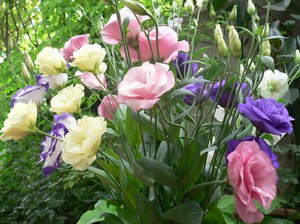 The adorable eustoma, which is incredibly similar to a rose, conquers everyone who looks at it with its appearance. However, few take on its cultivation, despite the fact that this flower does not cause any special worries. The most important thing is patience.
The adorable eustoma, which is incredibly similar to a rose, conquers everyone who looks at it with its appearance. However, few take on its cultivation, despite the fact that this flower does not cause any special worries. The most important thing is patience.
The flower is able to grow as in a dwarf size (25 cm) and tall (80 cm and above)... Eustoma can be grown on the balcony as well as in the garden. Its wonderful rose-like bud opens up in the form of a delightful double inflorescence, if at the sprouting stage the flower receives proper care and attention from the owner.
When you decide to give life to this little miracle flower, first familiarize yourself with all its requirements and whims. No need to believe when they say that this flower, which is very similar to a rose, is difficult to grow. Reproduction of eustoma takes place with the help of seeds, and since their size is too small, they are sold in granules.
Seedlings require special conditions:
- If you decide to decorate your garden with Lisianthus in the summer, then the seeds must be planted in the winter because this magnificent flower begins to bloom only after six months;
- In the case of choosing an eustoma, which is very similar to a rose for growing at home, choose a low-growing variety so as not to worry about a reliable support for the flower in the pot.
 Soil for this plant light and loose and neutral acidity preferred, since an increased acidity index slows down growth. It is also necessary to remember that the seeds of "rose" for germination require high humidity and heat, so the container for planting is covered with a film. It is necessary to sow eustoma seeds superficially and only slightly press them into the ground. As long as the seeds are film-coated, they do not need to be watered very often, although moisture control is very important.
Soil for this plant light and loose and neutral acidity preferred, since an increased acidity index slows down growth. It is also necessary to remember that the seeds of "rose" for germination require high humidity and heat, so the container for planting is covered with a film. It is necessary to sow eustoma seeds superficially and only slightly press them into the ground. As long as the seeds are film-coated, they do not need to be watered very often, although moisture control is very important.
Heat-loving sprouts during the day should be kept at a temperature about + 25o, and at night + 20o... Another important condition is illumination, because in winter there is not enough light, and small shoots weaken and stretch.
What are the features of caring for eustoma?
 To make the flower look more like a rose, it is necessary to prepare high-quality peat soil with a small admixture of sand. Some amateur flower growers use peat tablets. Flower seeds begin to sprout at a temperature of + 25 °... After about two weeks (after the shoots appear), the film must be removed and lamp bright lighting installed. With the onset of spring and the appearance of the sun, the sprouts begin to stretch out more quickly. An adult flower does not need to be watered abundantly, it will only be enough to prevent the earth from drying out.
To make the flower look more like a rose, it is necessary to prepare high-quality peat soil with a small admixture of sand. Some amateur flower growers use peat tablets. Flower seeds begin to sprout at a temperature of + 25 °... After about two weeks (after the shoots appear), the film must be removed and lamp bright lighting installed. With the onset of spring and the appearance of the sun, the sprouts begin to stretch out more quickly. An adult flower does not need to be watered abundantly, it will only be enough to prevent the earth from drying out.
Seedling protection from diseases can be provided fertilizers for flowers: epin, foundationol, zircon.
The picking of growths is carried out one and a half months after breaking through the soil. Pots with dived sprouts must be kept under a film for several days, and then accustomed to air. However, here it is important to know what is the humidity in the room. If the air is dry, this wonderful plant, similar to a rose, will not germinate well and may even die.
How to transplant seedlings?
 Eustoma is an amazing greenhouse plant, so it grows well in greenhouses. If you decide to grow a flower in a flower garden, choose the most illuminated place for it, which is closed from the cold wind. Please note that the plant requires special nutrition, so the soil should be fertile and light. When the "rose" begins to grow actively, it needs a good fertilizing with mineral fertilizers every week. Flower seedlings are planted in open ground only after spring frost however, even in this case, it is better to cover it slightly at night. Once the flowers have grown stronger, they will no longer need shelter.
Eustoma is an amazing greenhouse plant, so it grows well in greenhouses. If you decide to grow a flower in a flower garden, choose the most illuminated place for it, which is closed from the cold wind. Please note that the plant requires special nutrition, so the soil should be fertile and light. When the "rose" begins to grow actively, it needs a good fertilizing with mineral fertilizers every week. Flower seedlings are planted in open ground only after spring frost however, even in this case, it is better to cover it slightly at night. Once the flowers have grown stronger, they will no longer need shelter.
The indoor type of "rose" is planted in a pot when the seedlings have 4 leaves. A little expanded clay is poured at the bottom of the dishes.
Ranunculus is another flower that resembles a rose
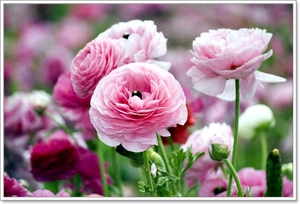 The Asiatic buttercup is a perennial plant very much like a rose. This flower is native to Asia Minor and southeastern Europe. Garden buttercup has tuberous roots up to 2.5 centimeters in length, and the stem reaches a height of 50 cm. The flowers themselves, resembling a rosebud, come in a variety of shades (sometimes two-colored with a border).
The Asiatic buttercup is a perennial plant very much like a rose. This flower is native to Asia Minor and southeastern Europe. Garden buttercup has tuberous roots up to 2.5 centimeters in length, and the stem reaches a height of 50 cm. The flowers themselves, resembling a rosebud, come in a variety of shades (sometimes two-colored with a border).
Flower leaves develop in winter and bloom occurs in spring. IN middle lane Buttercup blooms in two weeks, and its leaves dry out for the next fortnight. It should be borne in mind that the "Asian rose" does not tolerate frost, and an overly hot summer can slow down its growth. Because of these facts, many growers grow buttercups in a pot, and when the first cold snaps appear, they are brought into the house.
The most unpretentious variety of a flower that resembles a rose is peony ranunculus.
The Asian buttercup does not tolerate the swampiness of the site, but it also does not accept overdried soil. The soil for this flower should be moist, light and loosened.
How to care?
- Buttercup tubers resemble "crow's feet", and you need to choose them that there were at least four "claws". Before planting, it is advisable to wrap them in a wet rag and place them in a warm place for a couple of hours. In open ground, planting is carried out from mid-May;
- To achieve abundant flowering, once every half a month it is necessary to give the flower a dressing that contains a small proportion of nitrogen. After the first buds appear, flower growers switch to fertilizers containing potassium and phosphorus.
How to store tubers?
After the leaves turn yellow, you need to carefully dig out the tubers and soak them in a potassium permanganate solution for about 20 minutes. Then they need to be dried for about a week, and then stored in a dark and cool place, having previously sprinkled them with sawdust and sand.
Roses are wondrous royal flowers for all time. There are rare flowers that look like roses, which are also beautiful and adorable. When you see them, an association with a rose immediately arises, but, of course, there are differences, there are no thorns - protection and a symbol belonging to only one queen - the rose.
Similar flowers are very similar to the rose and are attractive to gardeners: peonies, Kalanchoe, gardenia, primrose, ranunculus, geranium, terry balsam, gardenia, adenium, begonia, eustoma. They do not have thorns, but in their own way they are all beautiful and adorable.
The Asian buttercup with various shades became known for the first time in Eastern countries since the 16th century. Beautiful flower is a worthy competitor among some garden favorites. It resembles a peony and a rose, resists many diseases, is not whimsical to care for.
Depending on the variety, the color can be pink, white raspberry, red, yellow, orange... When blooming, flowers reach up to 7 cm in diameter, are very similar to roses, form several buds when they reach a height of 30-35 cm.
Flowers last a long time, do not fade, after cutting, they are originally combined with other flowers in bouquets. Ranunculus is able to decorate any garden, it grows well at home in pots, but it is thermophilic, and quickly fades in the cold. For planting, seeds or bulbs are suitable directly into the ground.
Hibiscus, or Chinese rose, looks very much like a rose. This plant is not only indoor, but there are also hybrids, preferably grown in the garden. A perennial flower, luxurious bushes with buds form in the second year after planting. It blooms like an exotic plant, it is impossible to look without admiration.
The homeland of hibiscus is Asia, but today the plant grows beautifully in all countries of the world. The Chinese rose is compared to a symbol of beauty, sophistication, femininity.
The flower has 5 petals, which corresponds to the 5 commandments of Islam. The hybrids are quite adapted to our conditions and climate. They grow in bushes, like a rose, they are not afraid of frost, but they need to be covered for the winter, otherwise the roots and leaves may freeze.
There are a lot of buds on each branch, and the flowering duration is only 1 day, but new buds immediately bloom, which makes the flowering simply continuous, until mid-late October.
The hibisux of light rich pink shades grows up to 2 meters in height, the diameter of the flowers is 23-25 cm. The bushes of the plant are an excellent decoration for any area in the garden.

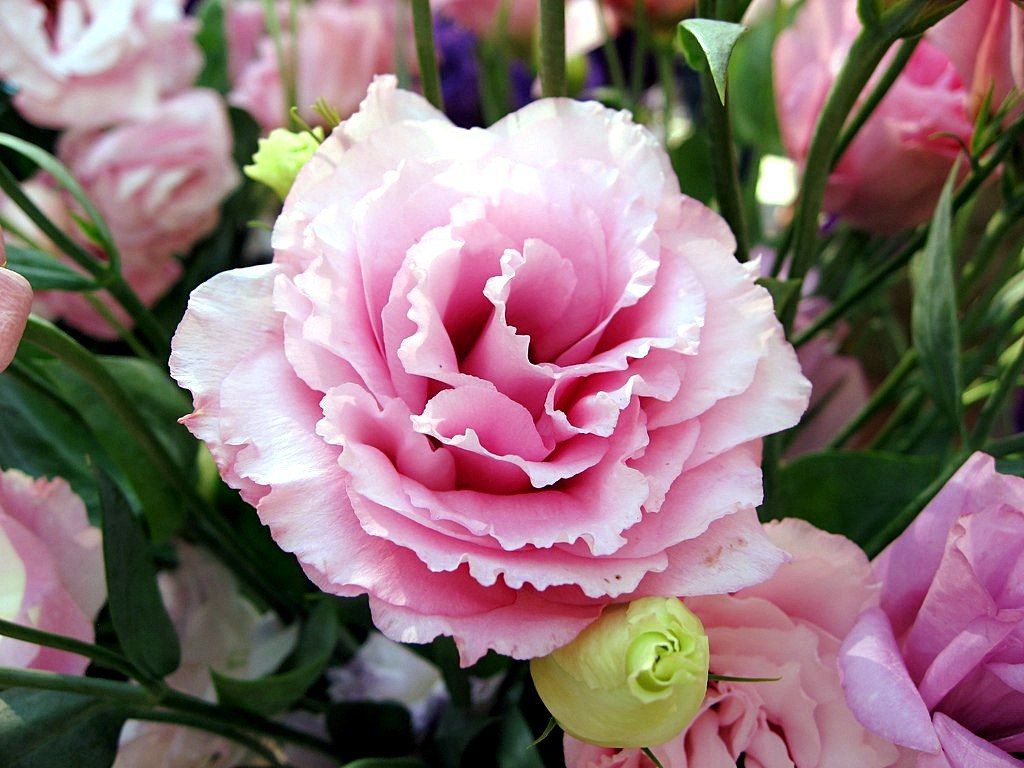
Eustoma is a worthy competitor to the queen-rose. This touching delicate flower is a favorite of gardeners. The birthplace of the plant - South America, but there are many hybrids today. There are known varieties with cream, red, white, apricot, lilac petals.
Flowers smell like roses, it's easy to confuse. The flower has a wide geography in distribution, therefore there are several names: Eustoma Irish, Japanese, French.
If you properly care for the plant, then the inflorescences will come out terry, juicy and luxurious. Flowers are propagated by seeds, or granules. There are tall varieties - hybrids, also dwarf ones, with bushes. 6 months after sowing, you can admire the luxurious flowering inflorescences.
Flowers grow indoors both in the room and in the open field. The composition of the soil is sand and peat, but you need to sow in a warm place at t not lower than 23 degrees, until the first shoots appear, you need to keep it under a film. After the emergence of seedlings, a pick of seedlings is carried out.
After the appearance of a real third leaf, transplant into a flower bed, if necessary. The plant loves light; when grown in a room in the summer, it should be taken out more often to the balcony, to the street.
Begonia is the rival of the rose, the favorite of the gardens. Plants bloom well, are unpretentious in care. The birthplace of begonias is Africa and South America, there are more than 900 species.
The sizes are different: miniature and gigantic, growing up to the ceiling in the room. Caring for begonias is not difficult. The main thing is that the soil is moist and water does not stagnate. For this it is necessary to make drainage.

New types of geranium
Geranium has no thorns, but is very similar to a rose. It grows beautifully on the balcony, windowsill, flower bed. It is believed that by planting a flower near the house, there will be no discord and bad weather in the family, and white inflorescences will increase the fertility of the family. Geranium is not only beautiful, but also creates a favorable microclimate in the house.
The birthplace of the flower is Africa. More than 280 species are known. Terry inflorescences with many petals are comparable to rosebuds, their full disclosure does not occur. Geranium should not be watered abundantly and kept in the sun, but the soil should not be allowed to dry out either.
For air penetration, it needs to be loosened more often, fed with top dressing. Watering is desirable with warm water.

People call balsam Vanka wet. Flowers, like roses, are very similar. Plants of short stature are perfect for landscaping the territory; they bloom profusely and grow on windowsills even in winter. Can be planted with seeds, cuttings in open ground. Thanks to the various shades, planting several varieties in one flowerbed, you can get real flower splendor.
It is not necessary to water the gardenia often, but it is necessary to loosen it periodically. Drying out, soil compaction should not be. Plants love shade, grow well under trees, in flower beds, as well as in vases, pots, baskets, containers. The flowering is generous. There is no need to oversaturate the soil with moisture, otherwise the stems will become brittle and brittle.
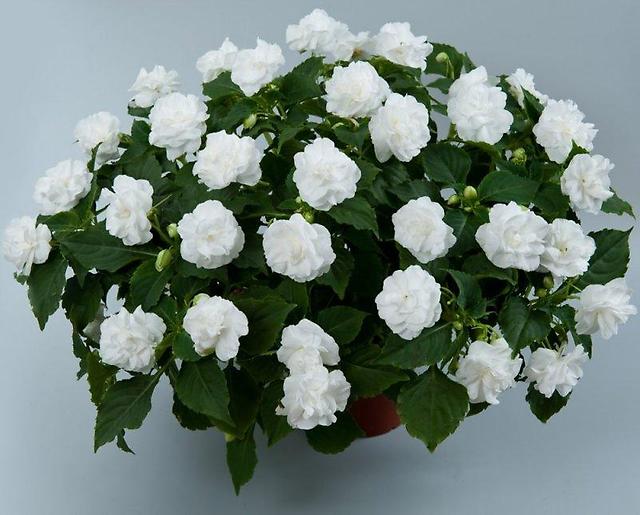
In terms of aroma, gardenia resembles jasmine, and in terms of appearance of course a rose. The plant is majestic, but loves warmth, affection and care. Depending on the species, it grows dwarf or tall in size. The flowers are arranged in pairs, but rather large, creamy white with dark green shiny leaves.
Flowering occurs in mid-summer and up to the month of October. Grown small bushes up to 0.5 meters high will become a real decoration of any interior. Bushes do not tolerate the scorching rays of the sun, but a lack of light will lead to stunted growth and growing season.
It is best to place the vases on the southwest side. If there is a lack of lighting, you need to put a luminescent lamp next to it.
You need to water the flower regularly, but in moderation, 1-2 times a month with the addition citric acid... The soil should be slightly acidic. It is not recommended to spray flowering.
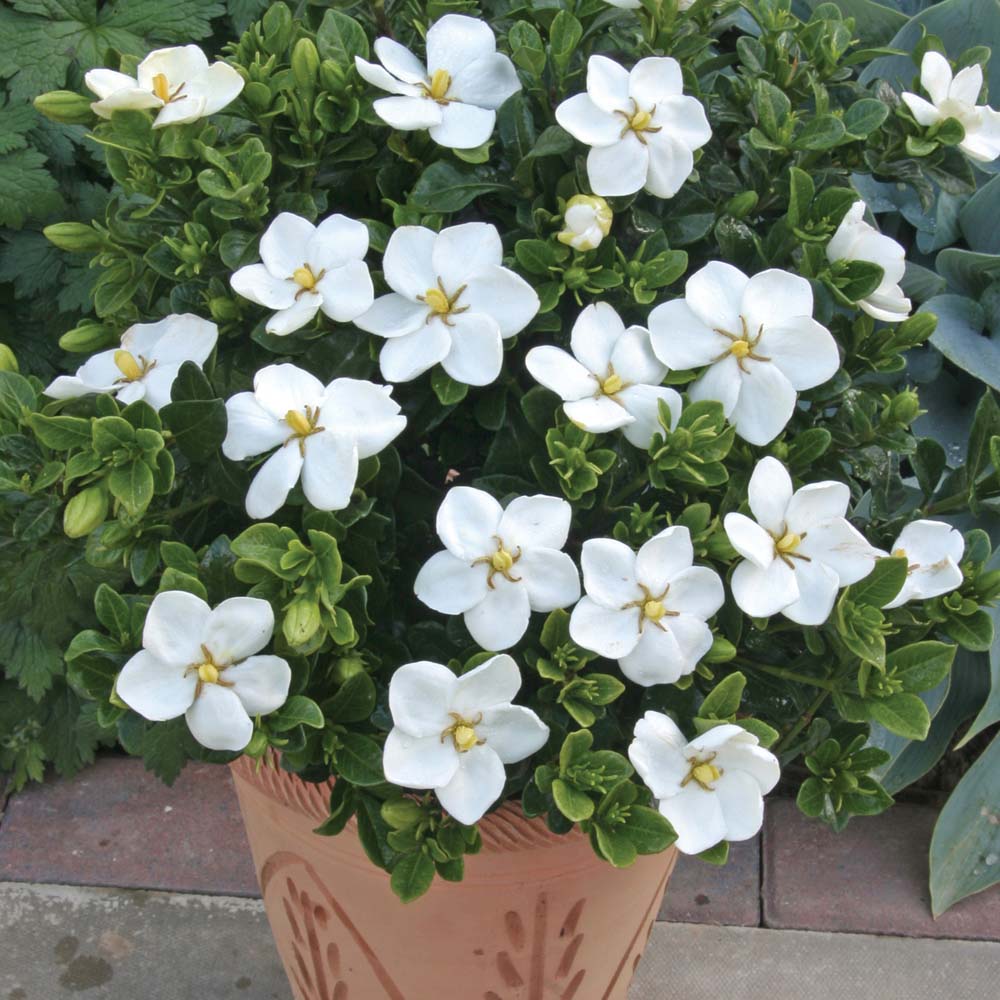
Adenium is considered a desert rose. Flowers can decorate any greenhouse or garden. It is a bushy succulent, the leaves are huge, olive-colored, and the flowers are graceful, with many different colors: white, red, with ebb.
The appearance of buds begins in early June and until autumn. They delight the eye with their luxury and splendor. The homeland of adenium is Central and South Africa.
When planted in the ground, the stems can reach up to 10 meters. At home, the height does not exceed 35-40 cm. Adenium blooms wonderfully, many owners seek to breed it in garden plots, but the juice is poisonous, you need to handle the plants carefully.
The plant is adapted to dry climates. Leaves absorb water and can hold on for a long time without any recharge. After watering, the plant begins to grow and bloom vigorously.
It is good to keep it outdoors in summer, fresh air speeds up the development process, but often it is not necessary to water. Leaves can be lightly sprayed, but water should not get on the inflorescences.

The plant is poisonous, but it became famous among the people for its healing properties... The frost-hardy black rose is a perennial evergreen that grows up to 30 cm in height, suitable for indoor cultivation. The roots grow long and creeping, so the hellebore pot should be tall enough.
A mixture of garden soil with clay is suitable as a soil. To drain moisture to the bottom of the pot, you need to drain. The plant grows well in a cool, dark place. After cutting, the hellebore stays in water for a long time, up to 1.5 weeks, but the water needs to be changed periodically.

Of course, the queen of any flower garden rightfully remains a rose, but all the listed flowers are very similar to it and are magnificent in their own way, worthy of preparing a place for any of them.
Rose favorites are able to decorate any garden plot: flower bed, windowsill, balcony. There is no need to doubt the luxury of these flowers, but you need to observe the peculiarities of growing each of them. Plants grow, bloom, and therefore live, require love, affection and proper care.
